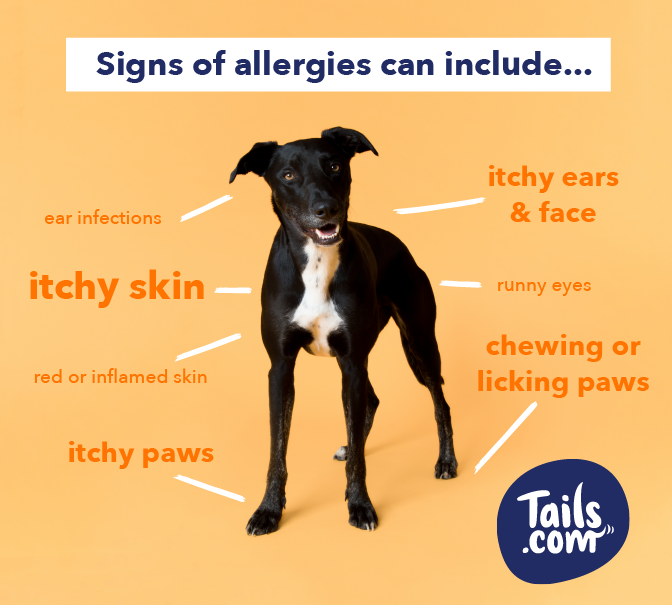They’re itching, they’re nibbling, their skin is looking a bit raw…their gas can clear a room. Ouch! If this sounds like your dog, let’s get sleuthing, because the answer could lie in their food bowl.
Like humans, dogs can be allergic or intolerant to particular foods. Only 10% of all allergies in dogs are food-related though, so it can take a bit of detective work between you (and your vet) to work out what’s going on.
But if you suspect your dog does have a food allergy, here’s what you can do to start tackling the problem.
How can I tell if my dog has a food allergy?

The naughty list
The most common dietary causes of allergy symptoms in dogs are these five:
- Beef
- Eggs
- Dairy
- Soya
- Wheat.
If you’re tackling a reaction, a good first step is to switch your dog to a hypoallergenic diet. If you’re a tails.com customer we make a unique recipe for your dog that cuts these culprits out – so your dog is less likely to suffer a reaction. (just click the link to find out more!)
When you’re figuring out what the cause is, it’s good to remember that environmental allergies share a lot of the same symptoms as food allergies, and are much more common.
The bad news? Dogs can have both types of allergy at once, which can throw you off the scent (pun intended) if you’re just looking at food issues.
Is it a dog food allergy – or an intolerance?
Food allergies and intolerances are different but symptoms can overlap, which isn’t great news when you’re in the middle of things like diarrhea, vomiting, loose stools, and other whiffy digestive issues.
Intolerances are much more common than true allergies – as symptoms tend to be more digestion-related.
We always say visit your vet. They’ll help you work out if your dog is suffering from an allergy, an intolerance, or something else. And whilst it’s difficult to diagnose, it’s always best to talk to a professional if you’re worried.
The exclusion zone
One of the ways to diagnose a food allergy or intolerance is with an exclusion diet. This means cutting out as many potential triggers as possible, and then reintroducing them one by one.
This helps you spot patterns in what your dog eats and what symptoms develop. It does need to be done carefully, so always get advice from your vet before you start.
Exclusion diets and tails.com
Tailormade food can work well for dogs on an exclusion diet – plus you know you’re giving your dog the right nutrition they need, while leaving out any ingredients that you think should be off-menu.
To keep things easy to manage, every tails.com dog gets an online profile where owners can track and update the ingredients they’ve excluded in just a few clicks.


Ebony was very sick with diaroea too for around a month. You gave me a 2 week supply of Sensitive stomach food, which along with an injection and pre-biotics have sorted the problem out.
Her delivery of food is almost due, but what is the best option? Pre-biotic food OR Sensitive stomache food OR try her back on what she was having?? Please can you help suggest the best way forward for her next delivery?
Hi Cheryl,
We’ll be happy to help out with this and make sure everything’s just right for Ebony. Can you send us an email to hello@tails.com so our team can help out?
Look forward to hearing from you.
Jack
This is a fantastic recipe, thank you for sharing it with us.